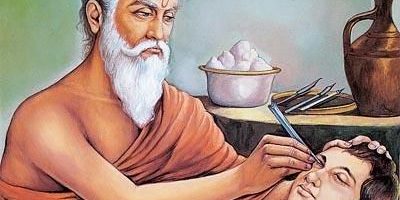 Sushruta (Around 800 BC) was an ancient Indian surgeon and is the author of the book Sushruta Samhita, in which he describes over 300 surgical procedures and 120 surgical instruments and classifies human surgery in 8 categories. He lived, taught and practiced his art on the banks of the Ganges in the area that corresponds to the present day city of Benares in North India. Because of his seminal and numerous contributions to the science and art of surgery he is also known by the title “Father of Surgery.” Much of what is known about this inventive surgeon is contained in a series of volumes he authored, which are collectively known as the Sushruta Samhita.
Sushruta (Around 800 BC) was an ancient Indian surgeon and is the author of the book Sushruta Samhita, in which he describes over 300 surgical procedures and 120 surgical instruments and classifies human surgery in 8 categories. He lived, taught and practiced his art on the banks of the Ganges in the area that corresponds to the present day city of Benares in North India. Because of his seminal and numerous contributions to the science and art of surgery he is also known by the title “Father of Surgery.” Much of what is known about this inventive surgeon is contained in a series of volumes he authored, which are collectively known as the Sushruta Samhita.
Contributions of Sushruta
There are numerous contributions made by Sushruta to the field of surgery. Surgical demonstration of techniques of making incisions, probing, extraction of foreign bodies, alkali and thermal cauterization, tooth extraction, excisions, trocars for draining abscess draining hydrocele and ascitic fluid. Described removal of the prostate gland, urethral stricture dilatation, vesiculolithotomy, hernia surgery, caesarian section, management of haemorrhoids, fistulae, laparotomy and management of intestinal obstruction, perforated intestines, accidental perforation of the abdomen with protrusion of omentum. Classified details of the six types of dislocations, twelve varieties of fractures and classification of the bones and their reaction to the injuries. Principles of fracture management, viz., traction, manipulation, appositions and stabilization including some measures of rehabilitation and fitting of prosthetics. Classification of eye diseases with signs, symptoms, prognosis, medical/surgical interventions and cataract surgery. Description of method of stitching the intestines by using ant-heads as stitching material. First to deal with embryology and sequential development of the structures of the fetus. Dissection and study of anatomy of human body. Introduction of wine to dull the pain of surgical incisions. Enumeration of 1120 illnesses and recommended diagnosis by inspection, palpation and auscultation.





